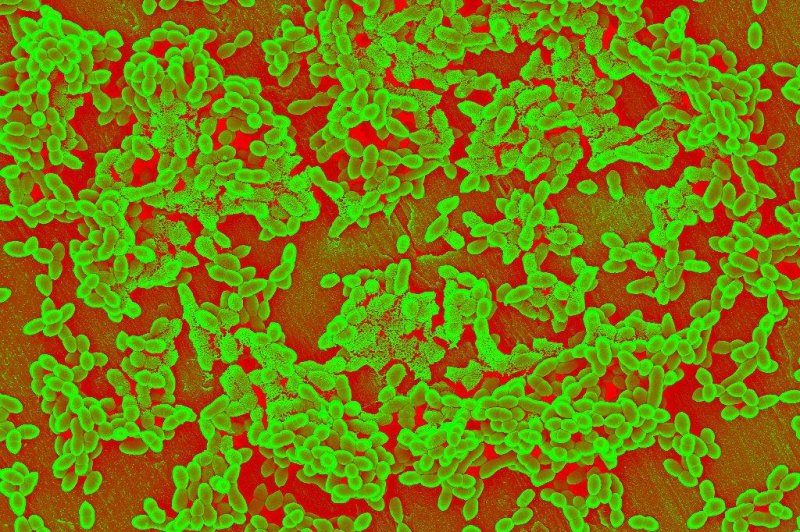Random gene activity among individual bacteria cells yields visible structural patterns of differentiated cells during the formation of biofilm. Photo by
Wikimedia Commons
Feb. 19 (UPI) -- New research suggests random gene pulses can produce the patterning necessary for the development of multicellular systems.
For even the most complex organisms, life begins as a single cell. The process of dividing and multiplying cells, as well as the process of differentiating cells, requires precise choreography.
Research suggests complex genetic instructions play a role in dictating these processes, but according to a new study -- published Wednesday in the journal Nature Communications -- random genetic activity can also produce patterns useful to the development of multicellular systems.
Scientists discovered the phenomena of patterned randomness while studying bacterial biofilms.
When single-celled bacteria attach to a surface and rapidly multiply, they can form a biofilm that spreads across the surface in a thin layer. The three-dimensional structure formed by the many individual cells can behave like a multicellular organism.
Individual bacteria cells are capable of surviving on their own, but organizing into the form of a biofilm offers several advantages, including increased resistance to a variety of environmental stresses.
To better understand how the individual bacteria cells in a biofilm cooperate, scientists deployed a unique time-lapse microscopy technique to observe their behavior.
"We looked at how cells decide to take on particular roles in the biofilm," study author Eugene Nadezhdin, researcher at the University of Cambridge, said in a news release. "We found that towards the surface of the biofilm there were two different cell types frequently present -- cells that form dormant spores and those that keep growing and activate protective stress responses. These two cell types are mutually exclusive, but they both could exist in the same location."
Using time-lapse microscopy, scientists watched changes in the gene expression for individual cell types. They observed one regulatory factor, called sigmaB, randomly pulses on and off every hour. The factor amplifies a cell's stress responses and blocks spore formation. The random gene activity produced a patterned distribution of the two different cell types, sporulating and stress-protected cells, across the biofilm.
To examine this pattern, scientists developed a mathematical model to simulate the random expression of sigmaB.
"The modelling revealed that the random pulsing means that at any one time only a fraction of cells will have high sigmaB activity and activation of the stress pathway, allowing the remainder of cells to choose to develop spores," said Niall Murphy, study author and Cambridge scientist. "While the pulsing is random, we were able to show through a simple mathematical model that increasing expression of the gene creates shifting patterns among the different regions of the biofilm."
The combination of direct observation and mathematical modeling showed random gene activity can result in spatial patterns among differentiated cells.
"This randomness appears to control the distribution of cell states within a population -- in this case a biofilm," said James Locke, biochemist at the Cambridge's Sainsbury Laboratory. "The insights gained from this work could be used to help engineer synthetic gene circuits for generating patterns in multi-cellular systems. Rather than the circuits needing a mechanism to control the fate of every cell individually, noise could be used to randomly distribute alternative tasks between neighboring cells."
Scientists hope followup experiments will help them understand whether the random patterns created by "noisy systems," like the pulsing of sigmaB, offer advantages over deterministic systems.















